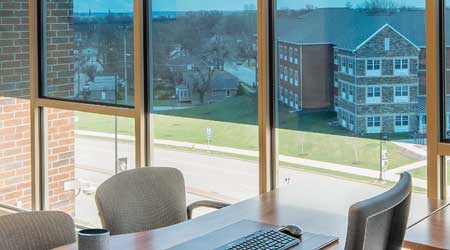 With simple voice commands, room occupants can use virtual assistants like Amazon Echo to control the tinting level of some electrochromic glass.SageGlass
With simple voice commands, room occupants can use virtual assistants like Amazon Echo to control the tinting level of some electrochromic glass.SageGlassBetter R-Value, Thermal Performance Highlight Window Advances
New assembly design strategies and materials give windows better R-value, daylighting, glare control, noise reduction, and lower solar heat gain coefficients.
3. Looks like a window, works like a wall. One challenge with upgrading windows has been the perception of poor ROI. Even in older buildings with single pane monolithic glass, facility managers have first looked to LEDs and other low-hanging fruit for energy efficiency gains. “They stayed away from the envelope because to go from single-pane monolithic glass to double-pane insulated glass and replace the windows, there wasn’t a very good ROI story there,” says Chad Simkins, director of sales and marketing with Guardian Glass.
Vacuum insulating glass (VIG) units solve this problem. They achieve the same R-value as brick wall assembly. Two fully tempered glass panes are held apart by nearly microscopic pillars, and because there is no gas between the panes, there is no medium to transfer heat. “With the VIG technology that we bring, you’re going from an R1 insulating value (of a single pane of glass) all the way to an R12 or an R14,” says Simkins. “Now you have this tremendous payback, plus you have all the other benefits of noise reduction and possibly increased daylighting.” Guardian Vacuum IG technology was first deployed in retail refrigerator doors as it is a very thin-profile lightweight product that doesn’t need to be electrified to prevent fogging, says Simkins. It is now starting to be installed in commercial facilities.
Other manufacturers have also developed vacuum insulating glass, but none before were suitable for architectural use in commercial applications, with appropriate safety glazing standards and high enough durability and performance, says Simkins.
4. Thermal performance. Other manufacturers have improved the thermal performance of their window units by changing the material of their spacers to be less conductive than traditional aluminum or steel. Viracon's extruded thermal plastic spacer performs 14 percent better than a standard aluminum air spacer, says Hoffman. These gains in efficiency help manufacturers keep up with more stringent energy codes.
New coatings also help windows meet code requirements. Vitro Architectural Glass' newest low-e coating, Solarban 90, can be applied to clear glass to preserve visible light transmittance while achieving a solar heat gain coefficient of .23. "Over the last five years, large buildings have become all glass," says Nathan McKenna, architectural manager, southeast, Vitro Architectural Glass. "With the increase in technology, such as low-e, you don't need walls as much." Codes help drive the adoption of new technology because the more efficient technology often has a higher first cost, even if long-term it makes economic sense.
Related Topics:












